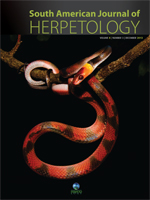Patterns of geographical variation in morphology provide an empirical framework for testing the effects of ecological and historical factors on species differentiation. Environmental gradients play an important role in intraspecific differentiation through morphological adaptation in locations with distinct selective pressures. Vanzosaura rubricauda is a small microteiid lizard that is widespread in the great diagonal of dry biomes of South America, occurring in Cerrado, Caatinga, and Chaco open habitats with contrasting environmental conditions. Using multivariate morphometrics and spatial analysis, we show that V. rubricauda presents a structured pattern of geographic variation, with populations of the eastern Cerrado being distinct in morphometry. Geographical variation was observed in size and shape, with a general trend of contrast between trunk length and forelimb length among populations. Ecogeographical models that best explained geographic patterns of variation were aridity and precipitation.
How to translate text using browser tools
1 December 2013
Spatial Variation in Morphometry in Vanzosaura rubricauda (Squamata, Gymnophthalmidae) from Open Habitats of South America and its Environmental Correlates
Renato Sousa Recoder,
Milton Cezar Ribeiro,
Miguel Trefaut Rodrigues
ACCESS THE FULL ARTICLE
ecogeography
Intraspecific Differentiation
Microteiids
morphometry
spatial analysis





